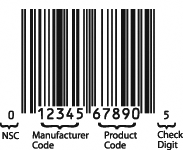What is a UPC Code?
The basic UPC code, referred to as Type A, is composed of twelve digits. These twelve digits are broken up into the four groups described below: Number System Character (NSC) The first digit represents the ‘number system’ of the UPC code. Most ‘normal’ products use number system zero (0), but several other number systems are also in use.
Manufacturer Code: The next five digits represent a ‘manufacturer code.’ Manufacturer codes are given out by the Uniform Code Council (UCC).
Product Code: The next five digits correspond to a specific product, and are issued by the manufacturer of the product. The meaning of these numbers are different for the UPC codes used on coupons.
UPC Code: Check Digit The last digit is used to check the integrity of the other digits in the number. The calculation is relatively simple. Calculating the Check Digit Assume the Number System Character is ‘A’, the Mfr Code is ‘BCDEF’, and the Product Code is ‘GHIJK’. Calculate A + C + E + G + I + K, multiply that by 3, then add B + D + F + H + J. The check digit is how much you have to add to that number to make it a multiple of ten.
An example: The UPC 04042100192X, where X is the check digit that we don’t know. We calculate (0 + 0 + 2 + 0 + 1 + 2) * 3 + (4 + 4 + 1 + 0 + 9) = 33. The check digit (X) is then 7, since we can add 7 to 33 and get a multiple of ten (40).
